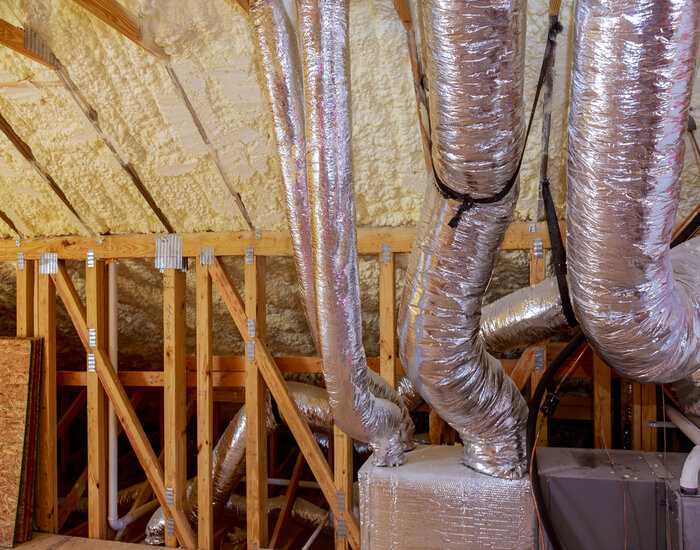
Worried about those attic vents?
Did you know that approximately 2% of building fires happen in the attic? That’s about 200 residential fires that happen each year because of a problem in the attic. Other significant problems in your attic may include black mold, mildew, or pests.
The best way to stay away from these problems is to understand the purpose of your attic and how to maintain it. In the sections below, we’ll dispel the myths of when closing the attic vents is warranted along with other common attic misconceptions. Read on.
Why does your attic have vents anyway? Most people know that attics help your house release excess heat during summer months. The attic acts as an intermediate layer. It bars the heat of your sun-drenched roof from the rest of your home.
The vents allow the super-heated air to flow out. Then, cooler air from outside sneaks in to replace it. In that way, it keeps your house cooler and your heating bills down.
It only seems logical that closing those same vents during the winter would help keep the warm air inside. That would, of course, reduce your heating bills and keep your home at a cozy temperature.
But there’s more to this puzzle, as you’ll discover in the sections below.
Just as you would size a furnace or air conditioner for your home, you also size your attic. You want a precise amount of ventilation to keep your home properly heated and cooled. If you have too much or too little, you’ll end up with energy inefficiency and moisture problems.
The same can be said of roof ventilation. Just as with space, too much or too little space will cause major problems.
Roof vents create additional access points for moisture to seep in and leaks to occur. Some vents are necessary. But if you needlessly increase your roof penetrations, you run greater risks:
So, how do you know how much ventilation you need? Without exception, speak to a professional contractor or architect. In general, homes need a ratio of 1:300.
For every 300 square feet of ceiling, you want 1 square foot of ventilation in your attic. Other factors to include are resistance and interference from things like grates, which impede air flow. That means that your entire vent opening doesn’t count as ventilated space.
Your roof ventilation can increase your energy efficiency during the summer. We discussed that earlier. What we didn’t mention was insulation, sun exposure, and shingle type are exponentially more important factors.
If they determine the dollars you save, your vents determine the cents.
Even if you own an old home that doesn’t have roof vents, installing vents may not be your best option. There are other, lower-risk, cost-effective ways to decrease your homes cooling bills.
But are air vents necessary in cold climates? Yes, they’re paramount, even if they require you to occasionally get rid of attic pests.
You see, the colder your climate, the higher the chance your home will benefit from ventilation. The colder it gets, the more you’ll have to contend with condensation. And condensation can be a home destroyer.
If your attic already has ventilation, it doesn’t have the high-rated rigid insulation you need for a closed attic. This insulation prevents condensation from seeping into your roof sheathing. It can cause mold, mildew, and even roof seepage.
Take into consideration how dew forms on the grass in the morning when cool, moist air hits warm sunlight. The warm air from your ceiling causes the same effect.
Over time, this condensation can cost tens of thousands of dollars in damage. Worse yet, black mold can have severe health consequences. That includes everything from allergies to pulmonary hemorrhages. It’s well worth it to keep those vents open and keep moisture out during the winter.
This is a common misconception. Because heat rises, people believe that ventilating your attic during the winter must mean you are letting hot air out. Which, in theory, would lead to higher energy bills, right?
But…
The loss of gain of heat in your attic is only marginally affected by your vents. We mentioned this earlier. Your insulation is hands down the determining factor in how well your attic retains heat. If you want to save money on your winter heating bills, replace your insulation with a newer, heavy duty option.
But be sure to check with an expert to make sure it’s the right kind. Getting the wrong kind on insulation can create as many problems as it fixes.
In general, your furnace should not be heating your attic. Whether you keep your vents open or closed will have a negligible effect on your power bill, but it’s sure to affect condensation.
Rooftop air vents are meant to be kept open year-round. They take little to no maintenance, but that doesn’t mean you should never check on them.
In order to keep your family safe, routinely check your entire home to make sure it’s in good running condition. Use a maintenance checklist to ensure you don’t forget anything. This winter, start in the attic and make sure your vents are open.
Then, check your furnace to make certain it’s functioning and/or your chimney to make sure it’s clear of debris. Then check the seals of all your doors and windows.
If you’ve done that and you’d still like to save money on your electricity bill, install heavy duty curtains. They can add an additional layer to the barrier keeping you warm.
Now that you know what to look for with your attic vents, you know not to touch anything. That’s great news. It means less work for you and more time to enjoy your favorite show. So, snuggle up and stay warm.
If you found this material helpful, come peruse our library full of articles on attics and renovations.
So long and good luck!